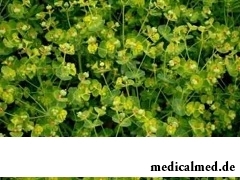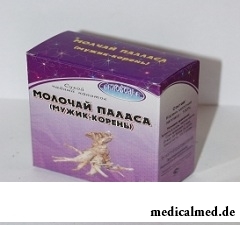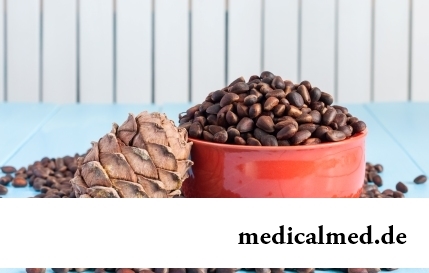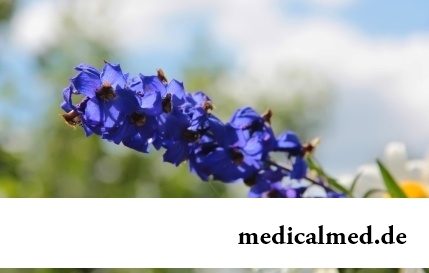





Pallas's euphorbia
Application instruction:
 Pallas's euphorbia (or Fischer) – the perennial herbaceous plant belonging to family the Spurge family.
Pallas's euphorbia (or Fischer) – the perennial herbaceous plant belonging to family the Spurge family.
Description
The plant has strongly developed root system, roots twisting, thick, juicy. Stalks reach up to 25 cm in height, often trimmed. Leaves are dense, have green with brownish a shade, and their form depends on a location on a stalk. Flowers of a plant are collected in umbrella-shaped inflorescences. The plant in May blossoms. A fruit – a three-hazel grove.
All elevated parts of an euphorbia of Pallas emit lacteal juice.
Plant strictly endemic. It is possible to meet him only in Transbaikalia, China and Mongolia. Grows on steppe slopes, prefers the shchebenisty and stony soil. This plant is included in the Red List of the Chita region.
History of use of an euphorbia of Pallas
There is a version that this plant and is that medieval mandrake. Reviews of Pallas's euphorbia, as about laxative and anthelmintic means are found in the ancient prescription book on the Tibetan medicine from which recipes were used since the time of Genghis Khan.
The Siberian doctors and herbalists in ancient times treated this plant tuberculosis, tumors and men's cannot.
Was considered that the root of an euphorbia of Pallas gives vital strength and prolongs youth.
With the medical purposes the root of an euphorbia of Pallas which is dug out in a plant wilting period is applied.
Chemical composition
The root of a plant contains phytosteroids, alkaloids, bitterness, glycosides, toxins, ascorbic acid, tannins, pitches, saponins.
All parts of a plant contain selenium.
Medicinal properties of an euphorbia of Pallas
Unfortunately, in scientific medicine medicinal properties of an euphorbia of Pallas are not applied today. Nevertheless, active researches on studying of properties and structure of a plant are conducted. It is already scientifically established that drugs on the basis of a plant can recover hormonal exchange in a male body, thanks to presence at a plant of phytoandrogens. Anticoagulating activity of this plant is established that gives the chance to use it in the long term for treatment of patients with disturbances of hemocoagulation. Immunomodulatory property of an euphorbia of Pallas is proved – the plant promotes healing of fabrics.
Availability of selenium in a plant allows to apply it to blood circulation stimulation. Drugs on the basis of a plant kill fungal flora and protozoa. And existence in roots of lactones gives the chance to suppress growth of tumor cells in an organism.
Reviews of an euphorbia to Pallasa demonstrate that it with success is applied in traditional medicine to treatment of malignant tumors of various character, including at a leukosis.
 In China doctors, thanks to medicinal properties of an euphorbia of Pallas, cure tuberculosis of lymphatic and bone system. In Tibet broth from roots cure a malignant anthrax.
In China doctors, thanks to medicinal properties of an euphorbia of Pallas, cure tuberculosis of lymphatic and bone system. In Tibet broth from roots cure a malignant anthrax.
Reviews of Pallas's euphorbia of herbalists demonstrate that it can be applied not only at diseases of a male reproductive system (infertility, erectile dysfunction, prostate adenoma, prostatitis), but also at mastopathies and a hysteromyoma at women.
One more indication to administration of drugs from this plant are anemias of various genesis, and also change in blood after himio-and radiation therapy in oncological practice. Plant roots also use for treatment of infectious diseases, diseases of a stomach and lungs.
At lymphadenites and limfangita do outside lotions of broth of roots of an euphorbia of Pallas.
Side effects and contraindications to use
At individual intolerance it is not necessary to accept drugs from a plant. Besides, plants it is poisonous therefore at overdose disturbances of a cordial rhythm, a liquid chair with impurity of blood and vomiting are possible.
When lovers kiss, each of them loses 6,4 calories a minute, but at the same time they exchange nearly 300 species of various bacteria.

Residents of big cities quite often have a disease which is known as the syndrome of chronic fatigue (SCF) today. This illness...
Section: Articles about health
Long time antibiotics were considered as a panacea from all diseases and were appointed even at insignificant symptoms of an infection. Even now not everyone knows in what force of antibiotics how and when they should be accepted. Let's discredit 7 popular myths about such drugs...
Section: Articles about health
Aspirin (acetylsalicylic acid) – one of those drugs which are known literally to all. It is available in each home first-aid kit, and many accept it at the first signs of an indisposition, often without having a fair idea of properties and therapeutic effect of drug. Meanwhile, impact of aspirin on a human body is very various, and is not always favorable. About it it is important to foreknow, in order to avoid emergence of problems with health....
Section: Articles about health
Statistically, in Russia about 34% of citizens smoke. Most of consumers of tobacco has problems about health sooner or later...
Section: Articles about health
The winter swimming in open reservoirs called in our country by "winter swimming" – officially recognized sport and one of the most extreme ways of a hardening of an organism. This occupation has an old story and adherents in many countries. Are annually carried out...
Section: Articles about health
Small appetite at the child – the complaint which pediatricians should hear practically from each mother. Most often it is carried to the category of children's whims, however the refusal of food in certain cases can be to alarming symptoms therefore it cannot be ignored....
Section: Articles about health
It seems, quite recently you brought the baby from maternity hospital, but time flew by, and here it is already going to join the first...
Section: Articles about health
Doctors claim that the people not so familiar with a dorsodynia occur among adult Russians very seldom. At the same time the vast majority of the patients who are periodically testing this indisposition do not hurry to ask for medical care at all. With one St...
Section: Articles about health
The hysteromyoma is diagnosed more than at a third of women 35 years are more senior. This high-quality new growth which at early stages successfully resolves by means of medicines. It is necessary to resort to an operative measure only when patients too late address specialists, or therapeutic methods do not give the expected effect because of specific features of an organism. Besides, there is a large number of quite effective national...
Section: Articles about health
Weakness of an ankle joint – very widespread problem. Its existence is demonstrated by tendency to a podvorachivaniye of legs п...
Section: Articles about health
Energy saving lamps are one of the most popular products of innovative technologies, and there is no wonder: they much more economic also are more long-lasting than usual filament lamps. At the same time there are fears that energy saving bulbs can become the reasons...
Section: Articles about health
All got used long ago that, having addressed the plastic surgeon, it is possible to modify natural parameters of a figure or to minimize the damages put to appearance with ruthless time. Many people (preferential women) worldwide annually decide on operations such. However there are also much more exotic interventions which are carried out seldom so far and cost expensive very much. We bring the story about the most unusual of them to your attention....
Section: Articles about health
It is impossible to imagine human life in which there would be no plants. Practically in each apartment and any of productions...
Section: Articles about health
On health of the person physicians know about salutary action of animals long ago. About 7 thousand years ago great Hippocrates recommended to the patients riding walks for strengthening of a nervous system and increase in vitality....
Section: Articles about health
Climax - process of fading of reproductive function of an organism in process of its aging. At women the main sign of its approach is the termination of a menstrual cycle. Officially the menopause is diagnosed when periods are not observed within 12 months. Age changes quite often are followed by emotional failures, disturbance of thermal control and sweating, dizzinesses and headaches, tachycardia and other unpleasant phenomena. This complex of symptoms...
Section: Articles about health
People know that thermal sources have salutary force long ago. Treatment by natural waters is one and...
Section: Articles about health
It would seem, about it there can be no disagreements: water is necessary for a human body for normal life activity, and about how and when it should be drunk, all know. It turned out that the situation is not absolutely so: for many years occur ве...
Section: Articles about health
A little more than a century ago goat milk was a traditional food stuff of most of Russians. Unfortunately, today on tables of our compatriots it appears extremely seldom. The reason that the use of so useful product practically came to naught, not only in very modest volumes of its production and, respectively, rather high cost. Potential consumers are just insufficiently informed on unique properties of goat milk and that advantage which...
Section: Articles about health
The brain of the person is studied not one hundred years, but the quantity of the riddles connected with this body increases rather, than reducing...
Section: Articles about health
The climax, or menopause is the normal process of the termination of genital function of the woman which is followed by serious hormonal changes in an organism. Usually the menopause begins at the age of 50-55 years, but characteristics of this process are very individual. T...
Section: Articles about health
When overcomes feeling of hunger, and an opportunity to have dinner fully is absent, having a snack − the meals, small on volume, stabilizing sugar level in blood comes to the rescue. The relation of nutritionists to having a snack more often negative, but only because as snack people choose the most caloric products with the increased amount of "bystry" carbohydrates: cookies, rolls, chips, candies. Nevertheless, the advantage of having a snack is obvious to weight loss: the person avoids strong feeling of hunger...
Section: Articles about health
The kid who was recently born is surrounded with love of adult family members and their cares without which the baby cannot exist....
Section: Articles about health
Osteoporosis this general disease which main sign is decrease in density of a bone tissue. On distribution width it takes the fourth place among noninfectious diseases. The illness develops at mature age more often: in our country to them harvest seasons...
Section: Articles about health
Cystitis, or inflammation of a mucous membrane of a bladder, this very widespread disease which, owing to some features of a structure of bodies of urinogenital system, women have approximately four times more often than men. Women aged from 20 up to 45 years enter into the main risk group. Cystitis is an illness of a bacterial origin. It can have an acute or chronic current. The second option is dangerous not only a frequent recurrence, серьезн...
Section: Articles about health
Sugar - the digestible refined product which is not of special value for an organism of the modern person. Use...
Section: Articles about health
Bathing in broths of medical flowers and plants (phytobathtub) was eurysynusic since Cleopatra who is a good judge in all that concerns beauty and health. And today phytobathtubs is the simple and available means allowing not only to remove nervous N...
Section: Articles about health
Diseases of joints often begin imperceptibly for the person. The first stages of destruction of the cartilaginous tissue providing soft and free sliding of heads of bones in joint bags proceed slowly and absolutely without serious consequences. Especially unpleasantly for the fact that this process is not connected with advanced age: degradation of joint surfaces is, as a rule, noticeable after 30 years. It means that practically each able-bodied person at any time can face sad results...
Section: Articles about health
